Over the weekend I posted a couple of photos of a vintage alto sax with mysterious extra keys, and asked if anyone could identify it. Some of you answered via comments, while others sent me emails.
So what brand of saxophone is it? It is an Oscar Adler Triumph model alto saxophone.
Source: A Friend Of Bassic Sax
The horn was correctly identified in an email by Attilio Berni. Berni, who is from Italy, has an enormous collection of rare and unique musical instruments, which he uses in his Italian Saxophobia project.
One of the rare horns in Berni’s collection, is a Triumph saxophone. (I suspect however, that Berni’s is not in need of a restoration.)
Source: A Friend Of Bassic Sax
According to Attilio Berni, the Triumph model was built with 11 extra keys, and had a range from low Bb to high G. Its key system is very similar to that of the Buffet Apogeé.
The Triumph was Oscar Adler’s top of line model of saxophone, had mother of pearl rollers, and a microtuner on the alto and tenor models. As of the 1930s, the Triumph was only available in alto, tenor, and C melody voices.
In his comment, Quinn didn’t know the manufacturer, but did correctly identify the city of manufacturing. Oscar Adler was indeed located in Markneukirchen.
If you’d like to read more about the company, I have the content of the Oscar Adler page finished now, but more pictures will be added over the coming days and weeks.



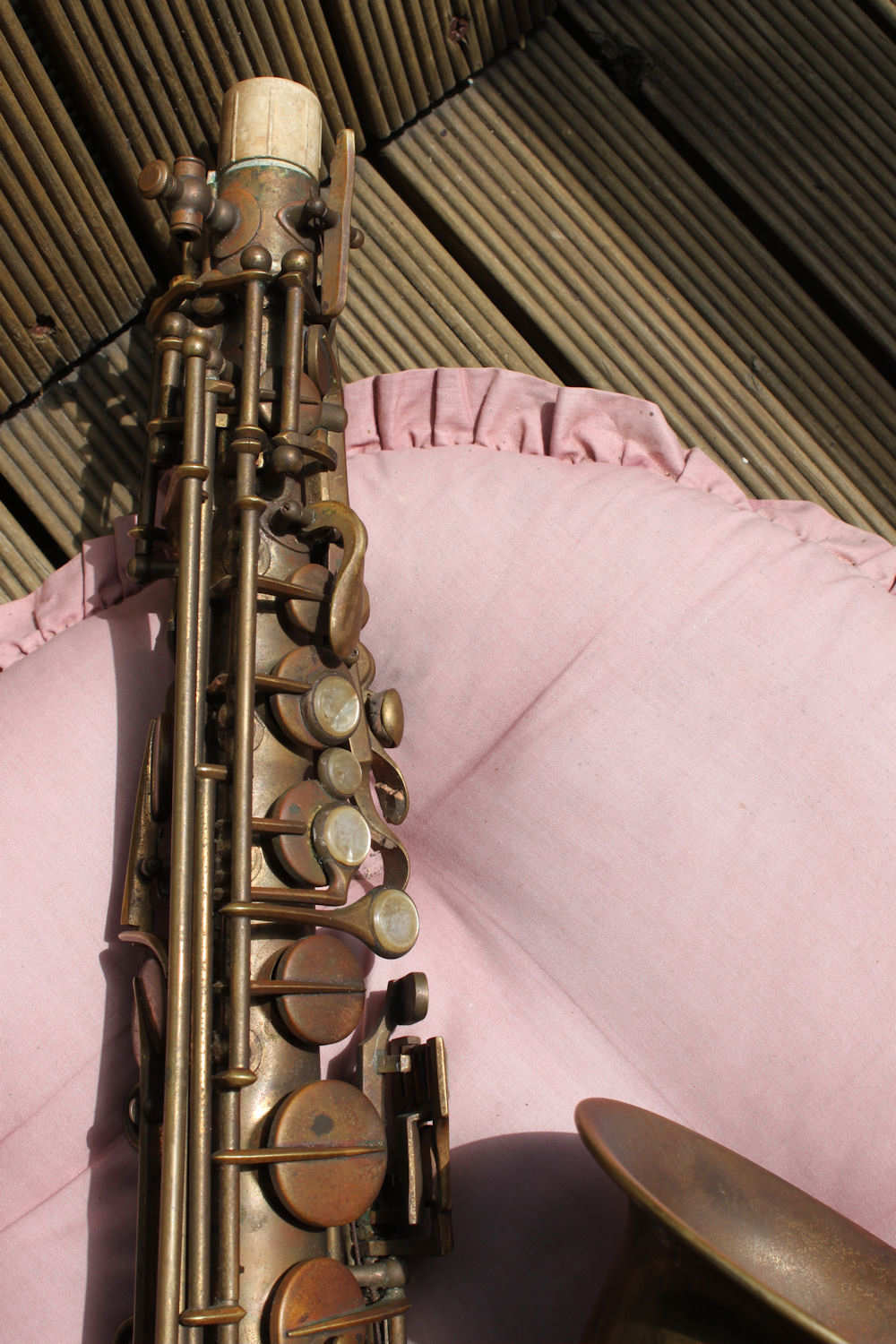
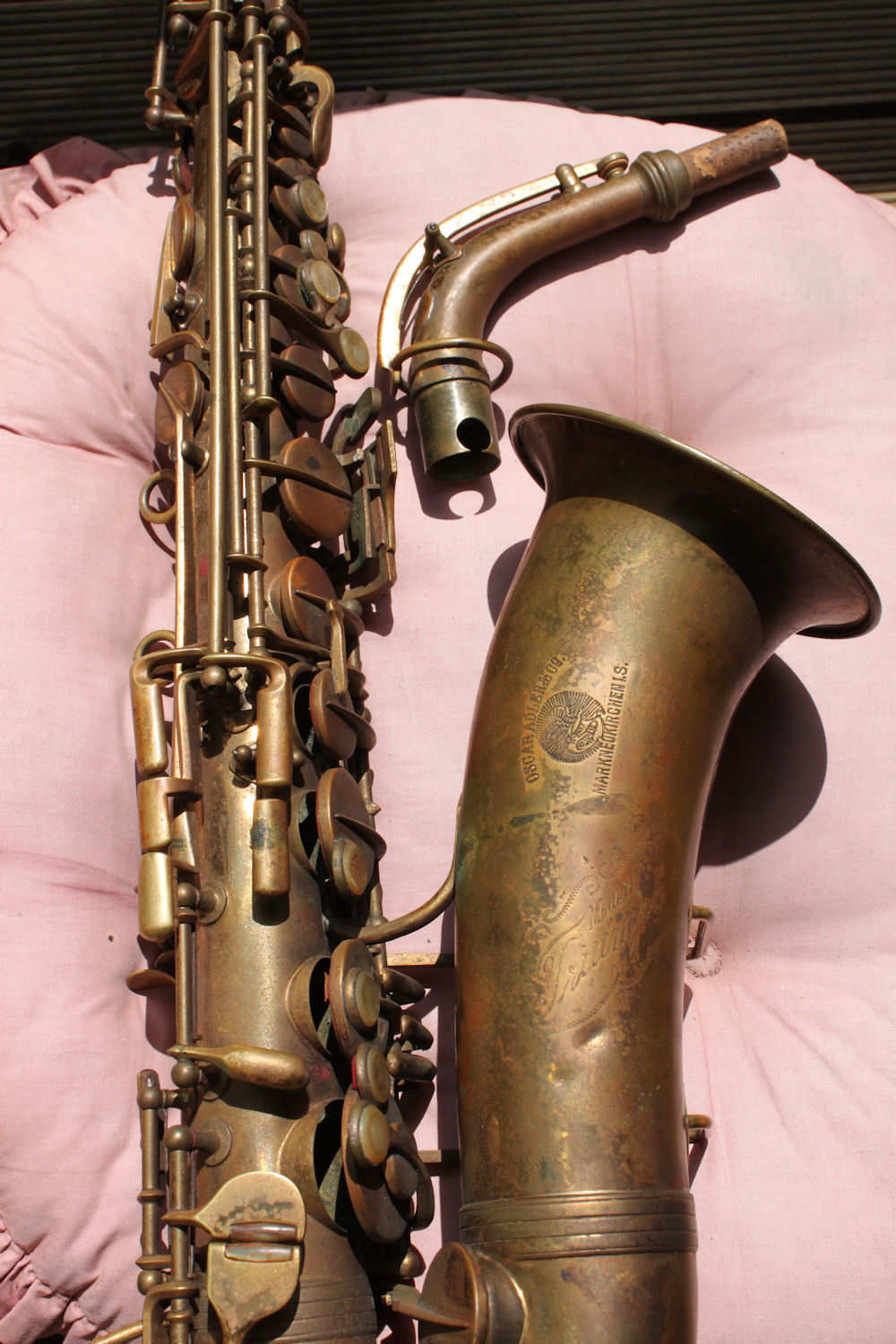

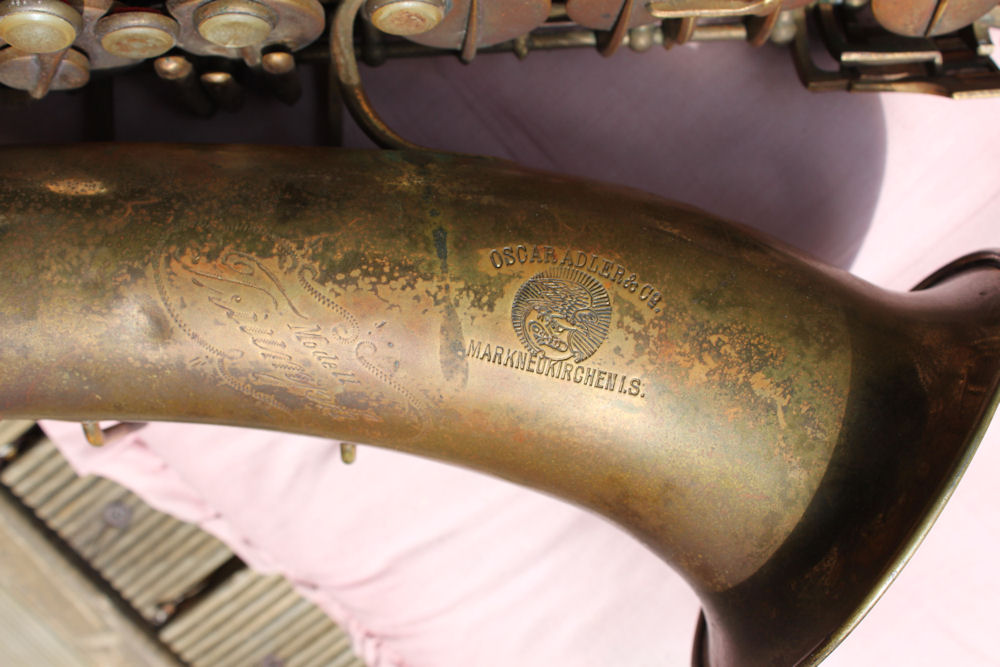
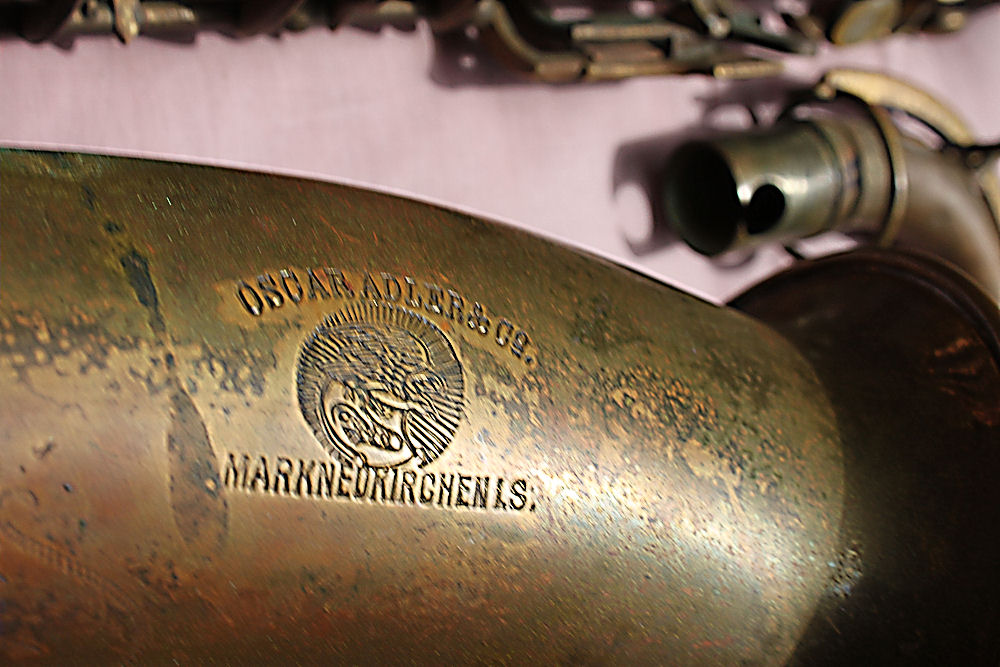

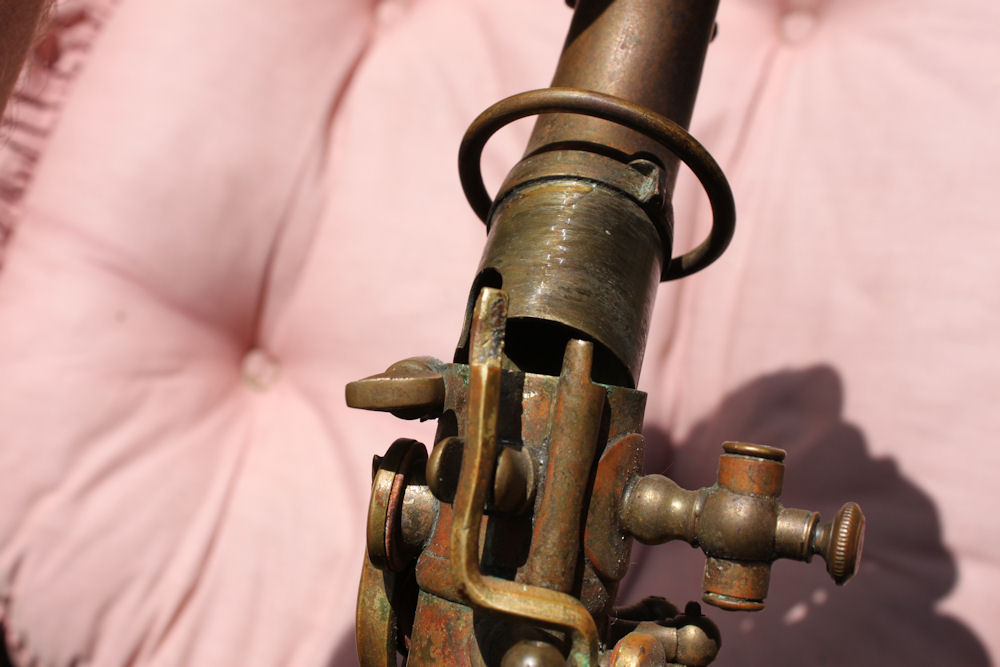
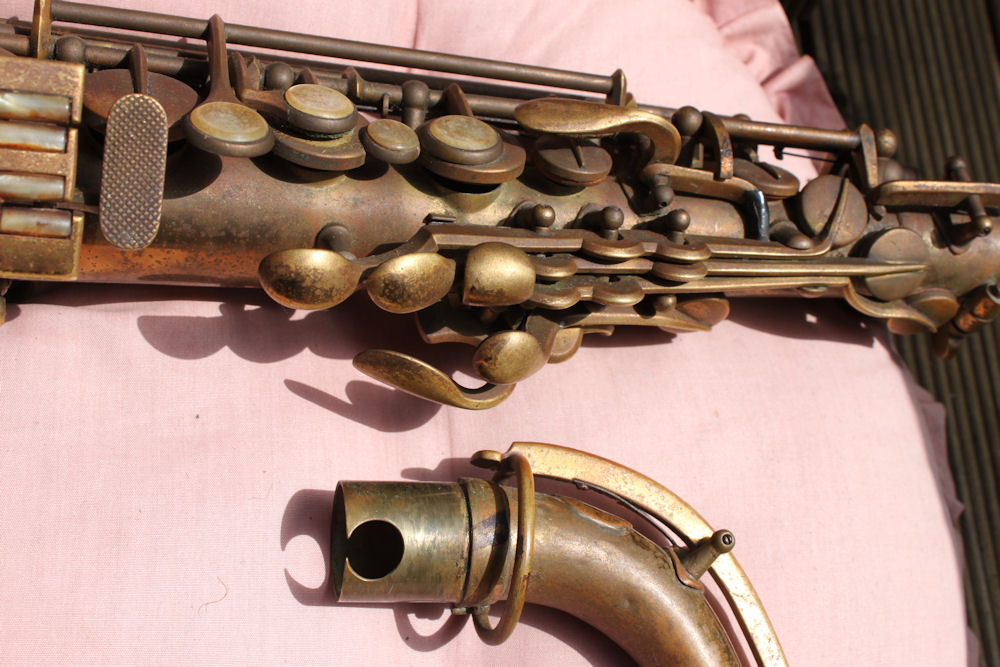





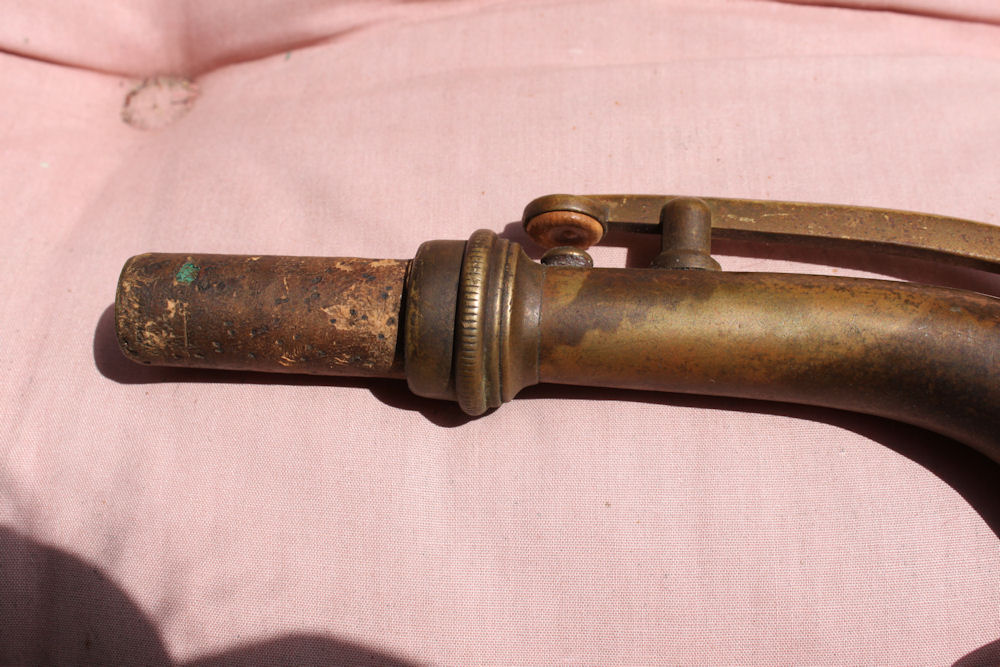

Pete, amongst the neck cut-out pics you have seen, are they all keyed to high-G, or, are they more likely to only be keyed to high F# like the Jupiter that Mal-2 kindly provided a pic of ? If there ARE any other VINTAGE horns keyed to high-G than just the OA Triumph, Conn-O-Sax and your quoted Couesnon model out there to actually warrant the phrase ‘whole bunch of horns’, please spill the beans.
Hi, Bob.
The neck cut-out/notch is on the Buffet S1, for instance, and that horn’s not keyed to altissimo G, just F#. I’ve got a pic at http://saxpics.com/the_gallery/buffet/s1/alto/lacquer/example1_multi.jpg. However, the notch may only be on the alto; I didn’t check the other pitches. Additionally, there was a European and American S1: the former was an A=442hz model and the latter was an A=440hz model. I think that the only difference was the neck — and it’s really easy to play in tune to A=442hz without using a different neck.
The “whole bunch of horns” comment referred to the notch in the neck, not the altissimo G. I claim “misquoted!” (No worries. Happens to me quite often.)
Anyhow, the Conn-O-Sax does not have a cut out in the neck (see http://thesax.info/gallery3/Conn/New-Wonder/22M-Conn-O-Sax-F-alto/22464x?page=3). However, if you look at http://thesax.info/gallery3/Conn/New-Wonder/22M-Conn-O-Sax-F-alto/22464x/ConnOSax100707a16, it looks very similar to one of the pics of the Adler that Helen posted — I think in part I.
I think it’s *possible* that there are A. Sax instruments keyed to altissimo G; I’ve been told that low A horns exist, so I don’t see why not. I’ve confirmed altissimo G on the low A Couesnons. I’d also think that is possible on other horns, particularly the “Germanic” ones: all Germanic horns tend to have very similar designs and I can easily envision a Kohlert & Sons or even a post-war Hohner with altissimo G. Reminds me to check out the Loomis “C melody” and the Leblanc System horns and earlier!
I doubt that the tenor would need a neck cutout unless it has a high G key — just about every tenor I’ve ever seen (that didn’t actually HAVE a high F#) had plenty of room to accommodate a high F# on the body without running into the tenon area, if it was desired to add one. I could see a C-mel having the cutout, if they had continued production into the high-F#-is-standard era we live in now. Baris and basses have relatively short necks so no problem there.
The lower of the two extra right palm keys appears to be a trill G# (it forces open, not the American trill G# which forces closed). The other does appear to be a trill D#, wrapped around the back of the horn. Unusual, but probably necessary with all the other extra tone holes already squeezed in. (I wonder how they affect the structural strength.)
The thumb keys do appear to be directly linked to low B (left) and C# (right), in addition to the Evette-Schaefer low touches and the fork Eb that vents through the center of RH3.
Having replaced a fair share of pads, including the pad-on-pad C# system of a few sopranos, I wouldn’t want to screw around with a large pad that had a hole in the center. That may be why it never really caught on (as opposed to the normal has-its-own-hole fork Eb, which was very common in its day).
Attached is the high F# tenon cutout of a Jupiter JAS-767. You can see it is a lot less fidgety on positioning than the horn this article is about, but it also has a slight expansion of bore size at this point which the tiny hole method prevents. Pick your poison I guess — and the expansion may not be a problem since tenons ideally shouldn’t be cylindrical inside anyhow. This cutout may actually approximate conical better than most.
Now for the $64,000 question — what do all the extra keys DO? I mean, clearly the triplicate keys where the high F normally lies are F#, G, and F (from top to bottom), but are the right thumb keys just duplicate touches for these? What about the extra palm touches in the right hand?
As for the count of the extra keys, I believe you mentioned there were 14. I count 6. They must be counting some things we consider standard now, like the front F.
Another thing I noticed was the minimal hole in the neck tenon for the high G hole, and the alignment peg and catch to make it match up. The high F# on my Jupiter 767 uses something similar, but they just cut out a larger notch on the tenon so that a fairly wide range of angles works rather than being restricted to one specific angle. (It’s still possible to assemble the horn such that it plays fine but the high F# does not function properly.)
I used to have a pic with all the various keys labeled, but I can’t find it ATM. The bottom (i.e. right hand) plateau keys are C#/B/Bb and it’s also got the funky fork Eb: this is probably licensed or borrowed from the Evette-Schaeffer and/or Apogee System — see my old page at http://saxpics.com/buffet/evette-schaeffer.htm for some further notes on that and the original patent.
The key behind the back of the horn right next to the thumbrest is B and the one right above the bow is possibly C#. I think. I can’t quite trace the linkage.
I’m *fairly* sure that the right side keys below the chromatic Bb are for altissimo F# and G, although quite a few companies did the altissimo D# trill, so one of those might be that.
That leaves the left side altissimo keys, which should be D/D#/E/F/F#/G.
The little cut-out in the neck, which I was very happy to see a good picture of, can be found on a whole bunch of horns. Looking at my older sax calendar hanging next to me, I can see a nice notch taken out of the neck of a low A/altissimo G Couesnon Monopole alto.
Again, thanks to Helen for finding this horn. I was waiting to see all the pics, because the Adlers I have pics of aren’t very good. I’d like to be able to pause that slideshow, tho 😛
Helen and I e-mailed a bit on this horn. I mentioned that there are horns with more keys, like the Raymond DuBois Essor (http://thesax.info/gallery3/Raymond-DuBois). Rampone also had horns with a lot of extra keywork. However, if you’re talking US-made horns, you’ve got the odd York that has a couple extra pearls for the right hand and the Holton Rudy Wiedoeft horns with their two extra keys, but these pale in comparison to the European horns.
Thanks for that Pete. I was hoping you’d chime in.
As for more pics, I put them up in my gallery. You can find Bob’s together with the original ones from the eBay ad here: http://bassic-sax.info/4images/categories.php?cat_id=1467
Attilio Berni also sent me 17 lovely, large, beautifully clear photos of his Triumph alto. I just need to resize them before I post them in the gallery.